@@Notes while editing@@
@@Should we include specific examples for the well known XML applications
(SVG, SMIL, MathML, VRML, WAP, etc)? -> make sure to keep up to date with
WCAG@@
@@Editor note: As part of the techniques writing process, changes are being
made to the text of success criteria and checkpoints. Once approved, these
changes need to be made back in the guideline document.@@
Introduction to Guideline 4:
This guideline requires that authoring tools must promote accessible authoring
practices within the tool as well as smoothly integrate any functions added
to meet the other requirements in this document. The checkpoint requirements
for this section include ensuring the priority for accessible means of completing
an authoring tasks (Checkpoint 4.1), ensuring the availability of accessibility-related
functions (Checkpoint 4.2), and ensuring that accessibility-related functions
fit into the appearance and interactive style of the tool (Checkpoint 4.4).
Checkpoints in Guideline 4:
- Techniques for checkpoint 4.2 Ensure
that the most accessible option for an authoring task is given priority. [Priority
2]
- Techniques for checkpoint 4.3 Ensure
that accessibility prompting, checking, repair functions and documentation
are always clearly available to the author [Priority 2]
- Techniques for checkpoint
4.X Ensure that accessibility prompting, checking, repair and documentation
functions are configurable [Priority 2]
- Techniques for checkpoint 4.1. Ensure that
accessibility prompting, checking, repair functions and documentation are
integrated into the workflow of Web Content development. [Priority 2]
- Techniques for checkpoint 4.4 Ensure
that accessibility prompting, checking, repair functions and documentation
are naturally integrated into the appearance and interactive style of the
tool. [Priority 3]
Notes:
- These techniques are informative. There are no claims made, implicit or
explicit, that by following any of the techniques in this document any conformance
requirements of the ATAG2.0 WD will be satisfied. Rather, these techniques
represent an illustrative sampling of approaches that might be useful in considering
the subject of authoring tool accessibility. There may be many other ways
a tool might be designed and still meet the normative criteria contained in
the success criteria.
- The techniques all use the phrasing "can",
rather than "must" or "should". This is intended to reinforce
to the reader the non-normative status of this document. It should be noted
that some techniques are so important to meeting their respective success
criteria, that for all practical purposes, the techniques are required. These
techniques have been marked with an asterisk (*).
ATAG Checkpoint 4.2: Ensure
that the most accessible option for an authoring task is given priority. [Priority
2]
Rationale: Authors are most likely to use the first and easiest
options.
Techniques for:
Success Criteria 1: When an authoring action has several more than one markup
implementations (e.g. the color of text can be changed with presentation markup
or style sheets) @@ changed by JR@@, those markup implementation(s) that meet
the requirements of WCAG must have equal or higher prominence
than those markup implementations that do not meet the @@WCAG@@ requirements.
ATAG Checkpoint 4.3: Ensure
that accessibility prompting, checking, repair functions and documentation are
always clearly available to the author [Priority 2]
Rationale: If the features that support accessible authoring
are difficult to find and activate, they are less likely to be used. Ideally,
these features should be turned on by default.
@@BAF: "logical" grouping rules should take precedence.
If necessary the accessibility options can be on separate pages if easily accessed
through the many flow of the application. Typically this will not be the case.
For example, have an "description" field as a part of an image selection
dialog is both natural and appropriate.@@
Techniques for:
Success Criteria 1: Continuously active processes (e.g. a checker that
underlines errors as they occur, a checker that runs at each save, a checker
that runs every 10 minutes, etc.) that implement functions required by checkpoints
3.1, 3.2, 3.3 and 3.7 must be enabled by default.



 |
Technique 4.3.1: Optrional continuously
active processes controlled by preference settings can br on be default. |



 Example 4.3.1: This illustration
shows the preference setting area of an authoring tool, open to an "Accessibility"
section. Settings that control continuously active processes are circled
in red. (Source: mockup by AUWG)
Example 4.3.1: This illustration
shows the preference setting area of an authoring tool, open to an "Accessibility"
section. Settings that control continuously active processes are circled
in red. (Source: mockup by AUWG)
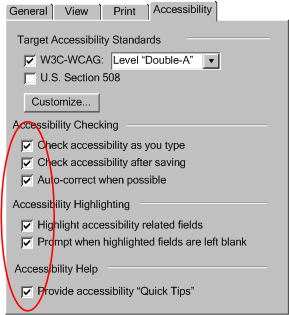 [longdesc missing]
[longdesc missing]
|
Techniques for:
Success Criteria 2: If the author chooses to disable these continuously
active processes, then the tool must inform the author of the
consequences of their choice.



 |
Technique 4.3.2: The tool can inform the author that
disabling any continuously active process may cause problems to develop
that might not otherwise. |



 Example 4.3.2: This dialog box might be activated if the author unchecks
a "highlighting accessibility related fields" feature, as shown
in figure 4.3.1. Notice that the wording
used in this example makes reference to the possibility that documents
will be "less accessible to many users" and that "in some
jurisdictions accessibility is a legal requirement". (Source: mockup
by AUWG)
Example 4.3.2: This dialog box might be activated if the author unchecks
a "highlighting accessibility related fields" feature, as shown
in figure 4.3.1. Notice that the wording
used in this example makes reference to the possibility that documents
will be "less accessible to many users" and that "in some
jurisdictions accessibility is a legal requirement". (Source: mockup
by AUWG)
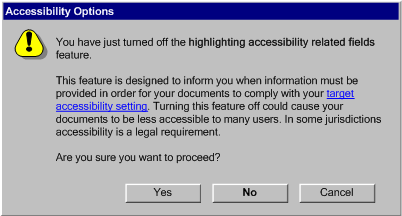 [longdesc missing]
[longdesc missing]
|
Techniques for:
Success Criteria 3: The accessibility-related @@accessibility prompting,
checking, repair and documentation@@ must have at least the same prominence
as@@ prompting, checking, repair and documentation@@ for other mandatory information
in the tool @@(e.g. prompting for file names during saves or checking for and
repairing spelling or syntax errors).@@
@@JR: the techniques here are pretty weak - we must ensure
they relate to success criteria@@
| |
Technique 4.3.3: Considerations for accessibility,
such as short text label and long description attributes, can appear on
the same dialog as the source attribute, rather than buried behind an
"Advanced..." button.
@@BAF: "can" should be "must" here.@@ |
| |
Technique 4.3.4: Efficient and fast
access to accessibility-related settings with as few steps as possible needed
to make any changes that will generate accessible content. (@@KM concerned about this@@)
|
| |
Technique 4.3.5: If
a single checker tool is implemented to detect spelling errors and accessibility
problems, the design can ensure equal visibility for the accessibility checking
component: @@JR@@
@@BAF spelling is an example of a verification action. this may lead
one to think its the only one (ie if no spell check, we can ignore this).@@ |
| |
Technique 4.3.6: Sometimes several
input fields must be filled in order to make a single element accessible.
Instead of dispersing these prompts over multiple dialog boxes, it can be
more effective to draw them together into one group of controls with a visible
tab or other method for accessing the group.@@new-from intro text@@ |
ATAG
Checkpoint 4.X: Ensure that accessibility prompting, checking, repair and
documentation functions are configurable. [Priority
2]
Rationale: A configurable tool is more likely to be adatpable
to the work habits or more authors.
Techniques for
Success Criteria 1: The configurability of functions related to accessibility
prompting, checking, repair,
and documentation must be equivalent to that of
comparable functions in terms of number of options controllable by the author
and the degree to which each option can be controlled.



 |
Technique 4.X.1:
Consider how much author configurability to provide.
Author acceptance of the accessibility features of an authoring tool
will likely depend on the degree to which these features can be integrated
into the existing workflows of authors. That is why the ATAG 2.0 definition
of "prompting" clearly states
that: "the form and timing that this prompting takes can be author
configurable". In other words, the author should be able to control
of how and when assistance in avoiding accessibility problems is rendered
by the tool. This author configurability will help reconcile the additional
accessibility authoring tasks with the regular work pattern of the author.
To achieve this, tools may offer the author a range of checking and prompting
options (see Figure 3.1.1), including: [@@new@@]
- which accessibility standards they wish to follow, and where applicable,
to which level,
- the degree to which the prompts are highlighted in the interface,
- the nature of the accessibility guidance they wish to receive, and
- the nature and timing of any automated accessibility features (e.g.
accessibility checking or correcting utilities).
|



 Example 3.1.1(a): This
illustration shows an accessibility preferences dialog that allows the
author to customize the nature of accessibility checking, highlighting
and help as well as set the accessibility standards the tool will check
against. (Source: mockup by AUWG)
Example 3.1.1(a): This
illustration shows an accessibility preferences dialog that allows the
author to customize the nature of accessibility checking, highlighting
and help as well as set the accessibility standards the tool will check
against. (Source: mockup by AUWG)
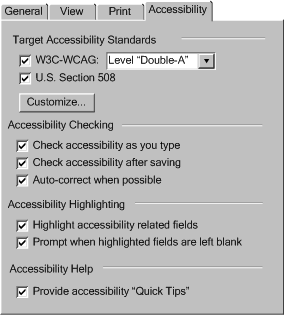 [longdesc
missing] [longdesc
missing]
|
 Example 3.1.1(b): This illustration shows shows a different preferences
layout, in which accessibility checking is just one of the checkers available
as the author enters text in a code-level authoring tool. Other checkers
are shown for spelling, syntax and usability. (Source: mockup by AUWG)@@added
due to BAF comment@@
Example 3.1.1(b): This illustration shows shows a different preferences
layout, in which accessibility checking is just one of the checkers available
as the author enters text in a code-level authoring tool. Other checkers
are shown for spelling, syntax and usability. (Source: mockup by AUWG)@@added
due to BAF comment@@
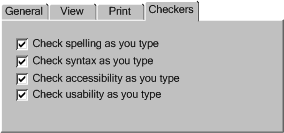
|
All functions that support accessible authoring
practices should allow author preferences to be configurable to allow for
different authoring styles. Custom configurations should improve use of the
tool and make authors more receptive to assistive interventions from the authoring
tool.
- section on configurability in techniques for checkpoint 3.1 could be used
as starting point for techniques for this checkpoint (4.X)
ATAG Checkpoint 4.1:
Ensure that accessible authoring practices are integrated into the workflow
of Web Content development. [Priority 2]
Rationale: Accessible design as an afterthought or separate
process is much more onerous and therefore costly than when accessibility is
considered from the start. If the authoring tool supports a workflow in which
the author considers accessibility before and/or during the authoring process
it is more likely that accessible authoring practices will become a common practice.
This is analogous to internationalization, which is much easier when it is considered
from the beginning rather than handled last.
Techniques for:
Success Criteria 1: Any mechanism that guides the author in sequencing authoring
actions (e.g. design aids, wizards, templates, etc.) must integrate
accessibility prompting, checking,
repair functions and documentation.
@@ BAF: Wizards are the way to go: . Repair tools can address
pre-existing content or content edits after use of a wizard (assuming you cannot
reenter the wizard). @@ @@BAF: wizards etc should be a major prompting mechanism.
Many samples should be shown such as the table example.@@
@@JT: Maybe have an example showing a template....?NTS?@@
@@JT: We need to have new techniques for tools that could
try to get author to put down structure first and seperately than presentation
- swappable styles@@



 |
Technique 4.1.1: Prompting can be integrated into
sequencing mechanisms (e.g. design aids, wizards, templates) at a point
early enough in the authoring process that there is less chance that it
will be bypassed. |
 Example 4.1.1: This illustration shows a wizard (indirect authoring) interface
that prompts the author for a few key pieces of information that will
then be used to generate a complete page; a gallery page in this case.
Since this step of the wizard includes a "Finish" button, this
is a suitable place to add the accessibility-related prompts ("label"
and "description"). Placing these prompts later in the process
would allow the author to bypass them. (Source: mockup by AUWG)
Example 4.1.1: This illustration shows a wizard (indirect authoring) interface
that prompts the author for a few key pieces of information that will
then be used to generate a complete page; a gallery page in this case.
Since this step of the wizard includes a "Finish" button, this
is a suitable place to add the accessibility-related prompts ("label"
and "description"). Placing these prompts later in the process
would allow the author to bypass them. (Source: mockup by AUWG)
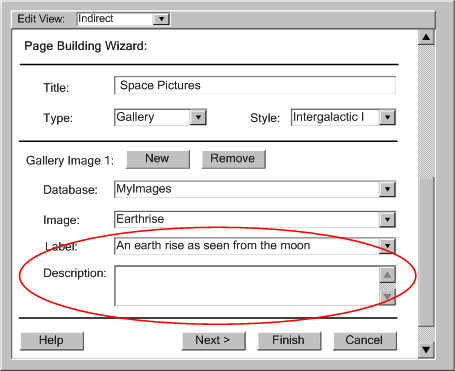 [longdesc
missing] [longdesc
missing]
|



 |
Technique 4.1.2: Checking that
is automated or semi-automated
can be integrated into sequencing mechanisms (e.g. design aids, wizards,
templates) |
|
Example: See 4.1.5(b)
|



 |
Technique 4.1.3: Repair that
is automated or semi-automated
can be integrated into sequencing mechanisms (e.g. design aids, wizards,
templates) |
| Example: This illustration shows
... @@PROCESS OF CONSTRUCTING CONTENT AND STRUCTURE BEFORE STYLING@@
|



 |
Technique 4.1.4: Immediate access
to some basic accessibility documentation and one-step access to more
comprehensive documentation can be provided to provide support to the
author as needed. |



 Example 4.1.4: This illustration shows an accessibility
checker with some limited short label authoring tips listed beneath the
text entry area as well as a button linking to the full documentation.
(Source: mockup by AUWG)
Example 4.1.4: This illustration shows an accessibility
checker with some limited short label authoring tips listed beneath the
text entry area as well as a button linking to the full documentation.
(Source: mockup by AUWG)
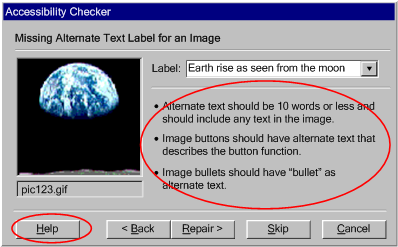 [longdesc
missing] [longdesc
missing]
|



 |
Technique 4.1.5: A tight coupling
between all of the accessibility-related functions leads to a more seamless
authoring experience. |
 Example 4.1.5(a,b,c): This illustration shows a sequence of steps through
a WYSIWYG interface in which prompting, checking, repair and documentation
of accessibility issues are all integrated into the process of creating
a table. In the first step (Figure 4.1.5(a)), the author has requested
that a table be inserted. The tool prompts the author for accessibility
information (i.e. caption and summary) at the same time as it prompts
for the number of rows and columns, etc. The tool assists the author by
filling both fields with known information (i.e. that this is the 3rd
table in the document). In the second step (Figure 4.1.5(b)), as the author
finishes filling in the top row of cells, the tool has checked the structure
of the table and found a lack of header cells. To address this problem,
the tool asks whether this "is a row of table headers". If the
author answers "Yes", then the tool can make the repair automatically.
In the third step (Figure 4.1.5(c)), the author has added a new row to
the top of the table and merged two cells in this new top row. The tool
again checks the table and asks the author whether this "merged cell
is a header for the column headers below it". If the author answers
"Yes", then the tool can repair the table structure accordingly.
In all three steps, key terms are linked directly to the help documentation.
(Source: mockup by AUWG)
Example 4.1.5(a,b,c): This illustration shows a sequence of steps through
a WYSIWYG interface in which prompting, checking, repair and documentation
of accessibility issues are all integrated into the process of creating
a table. In the first step (Figure 4.1.5(a)), the author has requested
that a table be inserted. The tool prompts the author for accessibility
information (i.e. caption and summary) at the same time as it prompts
for the number of rows and columns, etc. The tool assists the author by
filling both fields with known information (i.e. that this is the 3rd
table in the document). In the second step (Figure 4.1.5(b)), as the author
finishes filling in the top row of cells, the tool has checked the structure
of the table and found a lack of header cells. To address this problem,
the tool asks whether this "is a row of table headers". If the
author answers "Yes", then the tool can make the repair automatically.
In the third step (Figure 4.1.5(c)), the author has added a new row to
the top of the table and merged two cells in this new top row. The tool
again checks the table and asks the author whether this "merged cell
is a header for the column headers below it". If the author answers
"Yes", then the tool can repair the table structure accordingly.
In all three steps, key terms are linked directly to the help documentation.
(Source: mockup by AUWG)
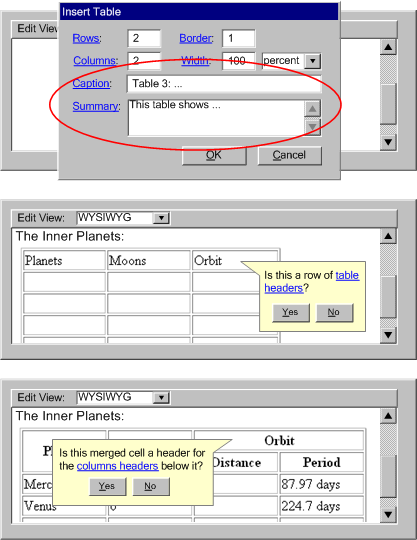 [longdesc
missing] [longdesc
missing]
|
ATAG
Checkpoint 4.4: Ensure that accessibility prompting, checking, repair
functions and documentation are naturally integrated into the appearance and
interactive style of the tool. [Priority 3]
Rationale: Most authors are reluctant to use features that
depart from the conventions of a tool. Detached accessibility
modules also decrease the likelihood authors will check for and repair accessibility
problems with their code.[@@added by MM@@]
Techniques for:
"Success Criteria 1: The user authoring
interface for accessibility prompting, checking, repair and documentation
must be @@equivalent@@ to the user
authoring interface for comparable functions in terms of the following
characteristics: [1] visual design (measured by design metaphors, artistic sophistication,
sizes, fonts, colors), [2] operation (measured by degree of automation, number
of actions for activation), [3] configurability (measured
by number and types of features), and [4] comprehensiveness (measured by
breadth and depth of functionality coverage)."
@@BAF: This one tends to be the default case (one would
rarely use a different style for accessibility prompting vs other prompting)
so wee need to make this more a thing to look out for vs a conscious design
action. We should include other samples in the pattern below.@@



 |
Technique 4.4.1: In some cases,
accessibility prompting can be equivalent to prompting for information
that is required for proper functioning. |
 Example 4.4.1: This illustration shows a dialog box in which the form
taken by accessibility prompting, for a text label and a long description,
and that taken by prompting for a required
Example 4.4.1: This illustration shows a dialog box in which the form
taken by accessibility prompting, for a text label and a long description,
and that taken by prompting for a required src attribute
are highly similar. (Source: mockup by AUWG )
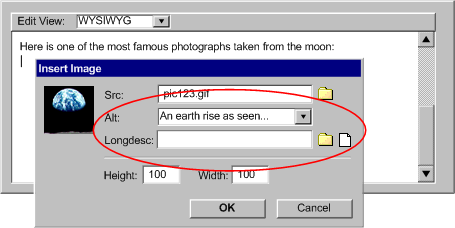 [longdesc
missing] [longdesc
missing]
|



 |
Technique 4.4.2: In some cases,
accessibility checking and repair mechanism can be equivalent to a code
syntax checking mechanisms or spell checking mechanisms. |
 Example 4.4.2(a,b): This illustration compares a syntax checker and an
accessibility checker in a code-level authoring tool. (Source: mockup
by AUWG )
Example 4.4.2(a,b): This illustration compares a syntax checker and an
accessibility checker in a code-level authoring tool. (Source: mockup
by AUWG )
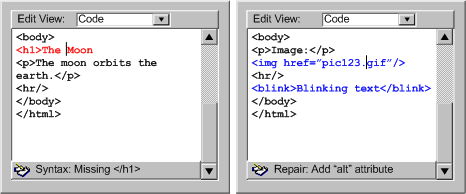 [longdesc
missing] [longdesc
missing]
|



 Example 4.4.2(c,d): This illustration compares a spell checker and an
accessibility checker. (Source: mockup by AUWG )
Example 4.4.2(c,d): This illustration compares a spell checker and an
accessibility checker. (Source: mockup by AUWG )
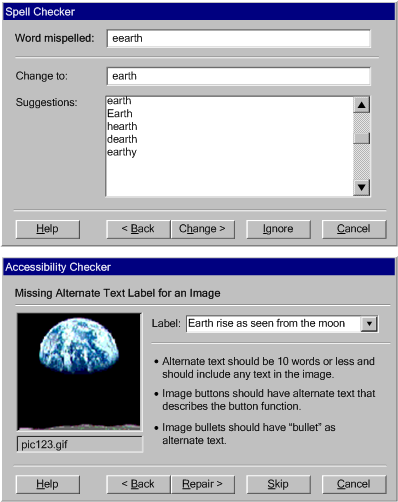 [longdesc
missing] [longdesc
missing]
|



 |
Technique 4.4.3: In most cases,
accessibility-related documentation can be equivalent to other documentation
in the tool. |



 Example 4.4.3: This illustration
shows how the accessibility documentation for a tool might look within
the main documentation feature. (Source: mockup by AUWG)
Example 4.4.3: This illustration
shows how the accessibility documentation for a tool might look within
the main documentation feature. (Source: mockup by AUWG)
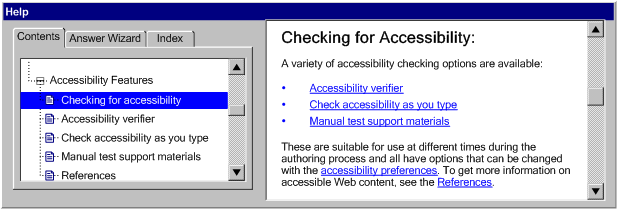 [longdesc
missing] [longdesc
missing]
|



 |
Technique 4.4.4: Consider providing
a common toolkit to aid in designing additional tool functionality modules.
This might be used internally or by third party developers to develop accessibility
plug-ins with the same look and feel as other parts of the tool.
|



 |
Technique 4.4.4: Consider designing accessibility features
as integral components of the authoring tool, not components that need to
be separately installed or executed.
|
Contents | Guideline 1 |
Guideline 2 | Guideline 3
| Guideline 4 | References
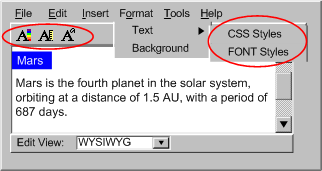




 [longdesc
missing]
[longdesc
missing] [longdesc
missing]
[longdesc
missing] [longdesc
missing]
[longdesc
missing] [longdesc
missing]
[longdesc
missing] [longdesc
missing]
[longdesc
missing] [longdesc
missing]
[longdesc
missing] [longdesc
missing]
[longdesc
missing]